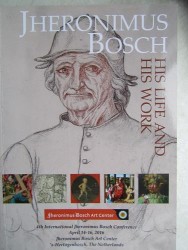
Blauensteiner 2016
“The Fall of Man and its consequences – Thoughts on the pictorial programme of Bosch’s The Garden of Earthly Delights” (Björn Blauensteiner) 2016
[in: Jo Timmermans (ed.), Jheronimus Bosch – His Life and hs Work – 4th International Jheronimus Bosch Conference - April 14-16, 2016 – Jheronimus Bosch Art Center – ’s-Hertogenbosch, The Netherlands. Jheronimus Bosch Art Center, ’s-Hertogenbosch, 2016, pp. 16-32]
Many of the figures in the foreground of the central panel of the Garden of Earthly Delights bear features that are very similar to Adam and Eve in the left interior panel. The foreground of the central panel could thus be read as a continuous narrative in which the same figures appear more than once within the same coherent landscape. In the final quarter of the 15th century, artists in the Southern Netherlands produced panels and tapestries in which many small figures (partly allegorical personifications and partly recurring characters of a continuous narrative) reappear in a landscape setting that is seen from an elevated vantage point and features a high horizon line, similar to the central panel of the Garden. The figures in the foreground of the Garden’s central panel could also be read as allegorical personifications.
Blauensteiner then argues that the Garden’s central panel is set in Eden and that it contains a number of allusions to the Fall of Man (which is not depicted on the left wing). Circa 1500 a number of authors and artists associated the Fall of Man with sexual lust. The erotic allusions in the Garden’s central panel seem to indicate that Bosch also interpreted the Fall of Man as a sexual act: the subject matter of the Fall is split up into countless allegorical scenes.
Because the landscape in the right interior panel shows architectural and artificial motifs it should be seen as an apocalyptic vision of hell on earth rather than as a representation of hell in a strict sense. The triptych as a whole presents a pessimistic history of man, ranging from the Creation of the World in the closed wings and the Creation and Fall of Man in the left and central inner panels to the right interior panel showing the consequences of the Fall in the form of an allegory of the grim state of society at Bosch’s own time. The Garden seems not to have served purposes traditionally associated with religious painting despite its (partly) Biblical subject matter and its triptych format, but was more likely intended to stimulate reflections upon the nature, history, and fate of mankind.
After all this, a good question would be: if the central panel is set in Eden and depicts the Fall of Man, where do the black men and women come from?
[explicit 6th April 2017]